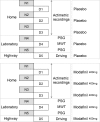Modafinil improves real driving performance in patients with hypersomnia: a randomized double-blind placebo-controlled crossover clinical trial
- PMID: 24587570
- PMCID: PMC3920313
- DOI: 10.5665/sleep.3480
Modafinil improves real driving performance in patients with hypersomnia: a randomized double-blind placebo-controlled crossover clinical trial
Abstract
Study objective: Patients with excessive daytime sleepiness (EDS) are at high risk for driving accidents, and physicians are concerned by the effect of alerting drugs on driving skills of sleepy patients. No study has up to now investigated the effect of modafinil (a reference drug to treat EDS in patients with hypersomnia) on on-road driving performance of patients suffering from central hypersomnia. The objective is to evaluate in patients with central hypersomnia the effect of a wake-promoting drug on real driving performance and to assess the relationship between objective sleepiness and driving performance.
Design and participants: Randomized, crossover, double-blind placebo-controlled trial conducted among 13 patients with narcolepsy and 14 patients with idiopathic hypersomnia. Patients were randomly assigned to receive modafinil (400 mg) or placebo for 5 days prior to the driving test. Each condition was separated by at least 3 weeks of washout.
Measurements: Mean number of Inappropriate Line Crossings, Standard Deviation of Lateral Position of the vehicle and mean sleep latency in the Maintenance of Wakefulness Test were assessed.
Results: Modafinil reduced the mean number of Inappropriate Line Crossings and Standard Deviation of Lateral Position of the vehicle compared to placebo (F(1,25) = 4.88, P < 0.05 and F(1,25) = 3.87, P = 0.06 tendency). Mean sleep latency at the Maintenance of Wakefulness Test significantly correlated with the mean number of Inappropriate Line Crossings (r = -0.41, P < 0.001).
Conclusions: Modafinil improves driving performance in patients with narcolepsy and idiopathic hypersomnia. The Maintenance of Wakefulness Test is a suitable clinical tool to assess fitness to drive in this population.
Keywords: Automobile driving; MWT; idiopathic hypersomnia; modafinil; narcolepsy; sleepiness.
Figures



References
-
- Philip P, Sagaspe P, Lagarde E, et al. Sleep disorders and accidental risk in a large group of regular registered highway drivers. Sleep Med. 2010;11:973–9. - PubMed
-
- Blazejewski S, Girodet PO, Orriols L, Capelli A, Moore N. Factors associated with serious traffic crashes: a prospective study in southwest France. Arch Intern Med. 2012;172:1039–41. - PubMed
-
- Connor J, Whitlock G, Norton R, Jackson R. The role of driver sleepiness in car crashes: a systematic review of epidemiological studies. Accid Anal Prev. 2001;33:31–41. - PubMed
Publication types
MeSH terms
Substances
LinkOut - more resources
Full Text Sources
Other Literature Sources

